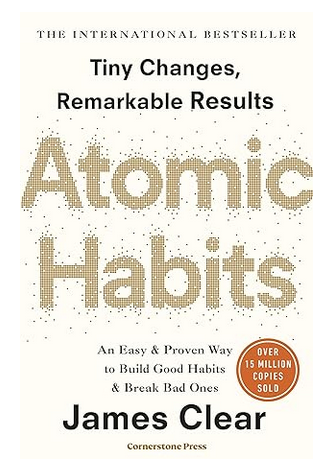“We are what we repeatedly do. Excellence, then, is not an act, but a habit.” – Aristotle
We all have goals we want to achieve—whether it’s losing weight, building a successful career, learning a new skill, or improving our relationships. Yet, despite our best intentions, many of us struggle to make lasting progress. Why is that? According to James Clear, the author of Atomic Habits, the problem isn’t necessarily our goals; it’s the systems we use to achieve them.
The Problem with Goals
“It’s not what we do once in a while that shapes our lives. It’s what we do consistently.” – Tony Robbins
Goals are important because they give us direction, but they are not enough on their own. Clear argues that focusing solely on goals can lead to frustration and disappointment. For example, if your goal is to run a marathon, simply setting that target won’t get you across the finish line. What you need is a system of habits—small, consistent actions—that will prepare your body and mind for the challenge.
The problem with goals is that they are often outcome-oriented. They focus on the end result rather than the process. And when we don’t see immediate progress, we get discouraged. Habits, on the other hand, are process-oriented. They are about showing up every day, even when the results aren’t visible yet.
The Compound Effect of Atomic Habits
“The world as we have created it is a process of our thinking. It cannot be changed without changing our thinking.” – Albert Einstein
Clear introduces the concept of atomic habits—tiny changes that seem insignificant in the moment but compound over time to produce remarkable results. Just as a single atom is a small unit of matter, an atomic habit is a small unit of behavior. But when you stack these small behaviors together, they create a powerful chain reaction.
Imagine improving by just 1% every day. It doesn’t sound like much, but over the course of a year, that 1% improvement compounds to make you 37 times better than where you started. Conversely, if you get 1% worse every day, you’ll decline nearly to zero. The same principle applies to habits. Small, consistent actions—whether positive or negative—add up to significant outcomes.
The Four Laws of Behavior Change
“Sow a thought, reap an action; sow an action, reap a habit; sow a habit, reap a character; sow a character, reap a destiny.” – Stephen R Covey
To build good habits and break bad ones, Clear outlines a framework called the Four Laws of Behavior Change. These laws are based on the idea that habits are formed through a feedback loop: cue, craving, response, and reward. By understanding and manipulating this loop, you can create systems that make good habits inevitable and bad habits difficult.
- Make It Obvious
The first step to building a habit is to make the cue obvious. For example, if you want to drink more water, place a water bottle on your desk where you can see it. If you want to exercise in the morning, lay out your workout clothes the night before. By making the cue visible, you increase the likelihood of taking action. - Make It Attractive
The more attractive a habit is, the more likely you are to repeat it. You can make a habit attractive by pairing it with something you enjoy. For instance, if you want to read more, create a cozy reading nook and pair your reading time with a cup of tea or coffee. This makes the habit more appealing and enjoyable. - Make It Easy
The easier a habit is to perform, the more likely you are to stick with it. Start with small, manageable actions. If you want to start running, begin with just five minutes a day. If you want to eat healthier, start by adding one serving of vegetables to your meals. Over time, you can gradually increase the difficulty. - Make It Satisfying
Finally, habits need to be satisfying to stick. Immediate rewards reinforce behavior. For example, if you want to save money, set up a system where you transfer a small amount into a savings account every time you make a purchase. Seeing your savings grow provides a sense of satisfaction and encourages you to continue.
The Role of Identity in Habit Formation
“Habits change into character.” – Ovid
One of the most powerful insights in Atomic Habits is the idea that habits are not just about what you do—they’re about who you believe you are. Clear emphasizes the importance of identity-based habits. Instead of focusing on outcomes (e.g., “I want to lose 20 pounds”), focus on becoming the type of person who embodies those outcomes (e.g., “I am someone who values health and fitness”).
Every time you perform a habit, you are casting a vote for the type of person you want to become. If you want to be a writer, write every day. If you want to be a runner, lace up your shoes and hit the pavement. Over time, these small actions reinforce your identity and make it easier to stick with your habits.
The Plateau of Latent Potential
“First say to yourself what you would be; and then do what you have to do.” – Epictetus
One of the challenges of building habits is that results often take time to appear. Clear calls this the Plateau of Latent Potential. You might work hard for weeks or months without seeing any visible progress. But beneath the surface, your efforts are compounding. Like a seed growing underground, the results are not immediately visible, but they are there.
The key is to trust the process and stay consistent. Breakthroughs often come after periods of stagnation. If you give up too soon, you’ll never reach the tipping point where your habits start to pay off.
In a Nutshell : Small Changes, Big Results
The message of Atomic Habits is simple but profound: small changes can lead to big results. By focusing on systems rather than goals, and by making tiny improvements every day, you can transform your life in ways you never thought possible.
Remember, habits are the compound interest of self-improvement. Start small, stay consistent, and let the power of atomic habits work in your favor. As James Clear writes, “You do not rise to the level of your goals. You fall to the level of your systems.” So build better systems, and watch your life transform—one atomic habit at a time.
Image Credit : Photo by Nathan Cowley

